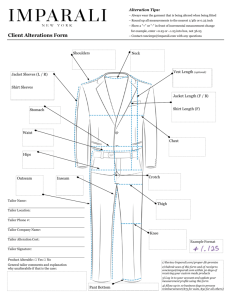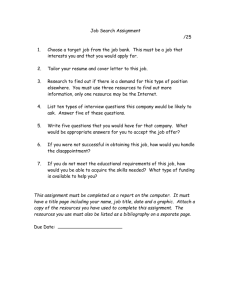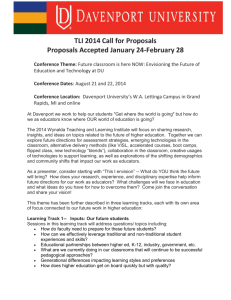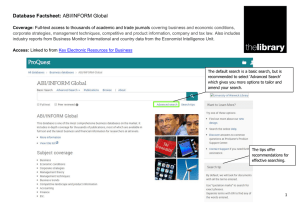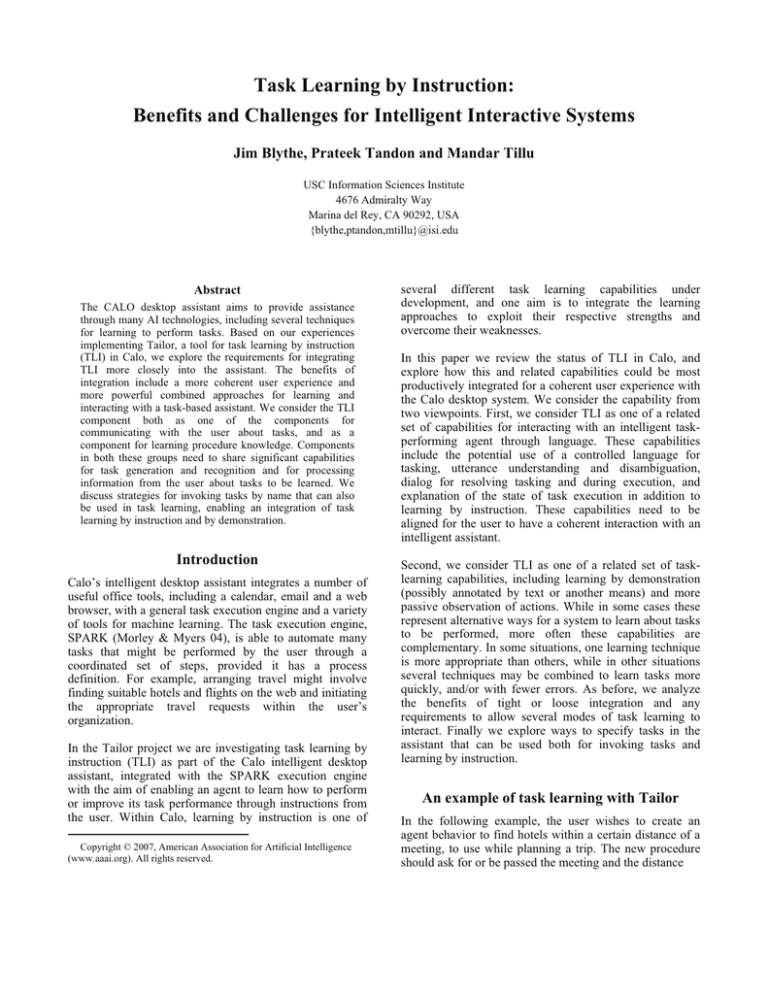
Task Learning by Instruction:
Benefits and Challenges for Intelligent Interactive Systems
Jim Blythe, Prateek Tandon and Mandar Tillu
USC Information Sciences Institute
4676 Admiralty Way
Marina del Rey, CA 90292, USA
{blythe,ptandon,mtillu}@isi.edu
Abstract
The CALO desktop assistant aims to provide assistance
through many AI technologies, including several techniques
for learning to perform tasks. Based on our experiences
implementing Tailor, a tool for task learning by instruction
(TLI) in Calo, we explore the requirements for integrating
TLI more closely into the assistant. The benefits of
integration include a more coherent user experience and
more powerful combined approaches for learning and
interacting with a task-based assistant. We consider the TLI
component both as one of the components for
communicating with the user about tasks, and as a
component for learning procedure knowledge. Components
in both these groups need to share significant capabilities
for task generation and recognition and for processing
information from the user about tasks to be learned. We
discuss strategies for invoking tasks by name that can also
be used in task learning, enabling an integration of task
learning by instruction and by demonstration.
Introduction
Calo’s intelligent desktop assistant integrates a number of
useful office tools, including a calendar, email and a web
browser, with a general task execution engine and a variety
of tools for machine learning. The task execution engine,
SPARK (Morley & Myers 04), is able to automate many
tasks that might be performed by the user through a
coordinated set of steps, provided it has a process
definition. For example, arranging travel might involve
finding suitable hotels and flights on the web and initiating
the appropriate travel requests within the user’s
organization.
In the Tailor project we are investigating task learning by
instruction (TLI) as part of the Calo intelligent desktop
assistant, integrated with the SPARK execution engine
with the aim of enabling an agent to learn how to perform
or improve its task performance through instructions from
the user. Within Calo, learning by instruction is one of
Copyright © 2007, American Association for Artificial Intelligence
(www.aaai.org). All rights reserved.
several different task learning capabilities under
development, and one aim is to integrate the learning
approaches to exploit their respective strengths and
overcome their weaknesses.
In this paper we review the status of TLI in Calo, and
explore how this and related capabilities could be most
productively integrated for a coherent user experience with
the Calo desktop system. We consider the capability from
two viewpoints. First, we consider TLI as one of a related
set of capabilities for interacting with an intelligent taskperforming agent through language. These capabilities
include the potential use of a controlled language for
tasking, utterance understanding and disambiguation,
dialog for resolving tasking and during execution, and
explanation of the state of task execution in addition to
learning by instruction. These capabilities need to be
aligned for the user to have a coherent interaction with an
intelligent assistant.
Second, we consider TLI as one of a related set of tasklearning capabilities, including learning by demonstration
(possibly annotated by text or another means) and more
passive observation of actions. While in some cases these
represent alternative ways for a system to learn about tasks
to be performed, more often these capabilities are
complementary. In some situations, one learning technique
is more appropriate than others, while in other situations
several techniques may be combined to learn tasks more
quickly, and/or with fewer errors. As before, we analyze
the benefits of tight or loose integration and any
requirements to allow several modes of task learning to
interact. Finally we explore ways to specify tasks in the
assistant that can be used both for invoking tasks and
learning by instruction.
An example of task learning with Tailor
In the following example, the user wishes to create an
agent behavior to find hotels within a certain distance of a
meeting, to use while planning a trip. The new procedure
should ask for or be passed the meeting and the distance
Figure 1. Tailor suggests input types for the initial procedure
Figure 2. A match is suggested for the user instruction that contains several steps
threshold. We assume the agent already knows procedures
to find hotels within a city given its name and state, and to
find the distance between two locations given by a street
address and zip code.
Figure 1 shows Tailor’s initial screen. The user has
indicated that the new procedure should accept a meeting
and a distance in miles, and can be referred to as “list
hotels within +miles miles of +meeting”, where +miles is
an input variable representing the distance and +meeting
represents the meeting. Tailor matches the variable
descriptions to types in the desktop ontology. This allows
the procedure to be invoked with the appropriate
information by other components in the desktop. For
example, the meeting can be specified via the Calendar.
In figure 2, Tailor has created the basic procedure and
suggested an initial procedure body based on the user
instruction “list each hotel name”. This procedure uses an
information extraction agent defined earlier to find
available hotels based on the city and the meeting dates,
the iterates over the hotels to build a list of their names.
This is Tailor’s highest-ranked suggestion for the
procedure body, since it is one of the smallest fragments
of executable code that matches the user’s request, but it
is not the only match. The menu in the middle window
shows alternatives, some for example that pick a single
hotel from the list rather than show them all. In many
cases the smallest matching fragment is a good choice,
but Tailor relies on the user to pick their preferred match
since there may be hard or soft constraints that are not
reflected in the agent’s world model. Sometimes, as here,
there can be many matches of the same size, leading to a
significant matching problem. We discuss this problem in
more detail later.
The user adds two more instructions to use the distance as
part of the procedure: “find the distance between the hotel
and the meeting” and “add if the distance is less than
+miles”. The first instruction leads Tailor to include a
primitive task that finds distances from the Yahoo web
site, based on a street address and zip code for each
location. Tailor automatically finds the required data for
the meeting and for each hotel. The second instruction
uses the distance in a threshold test.
The final procedure definition is shown in Figure 3, both
as Tailor shows it to the user and in executable form. The
procedure is also registered with the execution engine in
executable form as shown on the right hand side.
Figure 3. The final executable procedure after four instructions, with the executable version shown to the right.
The solution contains a number of steps that Tailor added
while composing the procedures for finding hotels and
computing distances to achieve the user’s goals. Since
these are both wrapper agents that return information from
online sources encoded in XML, Tailor added steps to
convert the information into a list of hotel objects that can
be manipulated in a SPARK procedure, and added calls to
additional steps to find the required information about each
hotel. It also extracts the distance from the returned XML
block and converts it to a number in order to compare it
with the threshold. In this way Tailor helps the user refer to
a growing set of available procedures by meaningful
names, combine them appropriately and encode the
procedure correctly in SPARK syntax.
In its current form, Tailor’s interface lacks several features
we desire in an intelligent assistant. We are currently
working to reduce its reliance on the user for the correct
types for input variables in a new task, improve its
reasoning about processes for making good coding choices
and giving salient warnings to the user, and to improve its
response when it has difficulty understanding the
instruction. In this paper we consider Tailor as a
component technology in a larger intelligent assistant, and
an important one since no other learning approach can
currently produce such complex procedure definitions
correctly from a small number of interactions without
using instruction. Based on our experiences with Tailor, we
discuss how task learning by instruction (TLI) can be
integrated with other capabilities to provide the assistant
with the ability to adapt its procedure knowledge.
Task learning by instruction as a component
method of task learning
Within Calo, a number of different methods for task
learning are under development. These include PrimTL, a
method to learn information access procedures that are not
inspectable by the execution engine (Lerman et al. 06), as
well as task learning by demonstration, by discussion and
by observation, which along with Tailor learn composite
procedure descriptions. We can characterize the composite
task learning components along two dimensions. First, they
differ by the amount of user interaction required to learn a
procedure. TLI is at one end of the spectrum, relying on
direct information from the user for all its knowledge.
Learning by discussion combines a demonstration of the
task with direct information from the user indicating
substeps, intermediate results and other information.
Learning by demonstration alone requires significantly less
user interaction than TLI, although the user must structure
the demonstration, indicate when the procedure is
beginning and when it has been achieved. Learning by
observation requires the least amount of user intervention,
relying on observed data from executions of the
procedures.
Task learning methods can also be distinguished by the
nature of the information that is passed. Tailor in its
current form uses no examples and relies on abstract
information about how the task is performed. Pure learning
by observation would use no information other than traces
of executions. The other systems use a mix of examples
and more general information.
Both dimensions impact the cases where the different
learning tools may be appropriate. If the task being
performed is not easily articulated by the user, such as UI
manipulation, then TLI is probably too intrusive and may
also lead to inaccurate procedure knowledge. In cases
where users can more easily talk about tasks than perform
them, however, such as purchasing equipment, TLI may be
faster and ultimately less obtrusive. In many cases, though,
more than one learning technique can be applied, and they
may be complementary. Learning by demonstration may
quickly pick up the essential actions and structure of a task,
while one or two instructions may correct slight errors in
generalization.
In most cases, several different task learning techniques
will be combined when the task is learned as efficiently
and unobtrusively as possible. It is not hard to imagine
cases where the most natural way for users to present
information changes several times during the same task. In
calendar-related tasks, for example, a learning episode
might begin when the user rejects a suggested time slot for
a meeting through the GUI, and re-assigns the meeting
with a gesture. However the proper generalization of a new
procedure describing the task may rely on semantic
information about the meeting type and participants that
can only efficiently be described through text. Finding the
best interpretation of the text, however, may require using
information from traces of previous similar meetings to
weight the alternative interpretations correctly.
To provide a coherent user experience while learning tasks,
the assistant needs to be very agile in switching from one
learning approach to another while presenting a unified
interface to the user. This implies that the learning systems
in Calo should ultimately share a good deal of their
interface, and share information captured in gestures, in
traces or through verbal interaction as well as sharing
intermediate hypotheses about the tasks being learned.
While the learning techniques available in the Calo
assistant have been developed independently, to our
knowledge this platform provides the best opportunity to
explore this agile use of different learning methodologies,
since the learning tools share a common platform and
target language.
Such cases also highlight the need for textual
representations for even purely graphical gestures made
while using the assistant, since at some point these actions
may need to be described while discussing a procedure at a
more general level. Most actions taken within a GUI have
interpretations at both a screen level (click here) and a task
level (attach the file to the email message) and both may be
appropriate at different times.
Task learning by instruction as languagebased interaction
The task learning capability in an interactive intelligent
assistant needs to be fully integrated with its other
capabilities to provide a seamless interactive experience
for the user. We can view task learning by instruction as
one of a set of related capabilities that allow the agent to
communicate with the user about tasks through language.
The user should therefore be able to refer to tasks in the
agent in the same way when initiating them as when
referring to tasks during TLI. This means the TLI and
language-based tasking must have access to the same set of
procedures as part of a global KB, and should provide the
same search capabilities for understanding tasks. Similarly,
the way that TLI describes learned procedures, and trees of
intentions triggered by a goal, should be the same as the
way the assistant refers to these procedures and intentions
during other tasks such as explanation and dialog.
For example, one module that allows the user to task Calo
through text is the Towel (Myers et al. 07), which uses a
conversational style similar to Diamond Help (Rich et al.
05). This system accesses the same set of procedures as
Tailor, but does not search for argument values based on
the current problem-solving state in the same way. A
coherent approach might also allow Towel to suggest
composing a small number of steps and queries to solve a
user goal that cannot be solved by a single procedure.
Calo's explanation module is centralized across problem
solving and inference (Pinheiro et al. 05), and can also
incorporate knowledge of procedure modifications from
Tailor into an explanation, but at present the two modules
use different routines to generate presentations.
An interesting consequence of a unified interface for
describing tasks for both learning and invoking them is that
it can sometimes reduce the distinction between learning
by instruction and learning by demonstration (TLD). In
learning by demonstration, the teacher signals the
beginning and end of a demonstration and performs a
sequence of actions that constitute executing an instance of
the procedure. The learning system records the actions and
subsequently generalizes them to broaden the applicability
of the learned procedure. Typically this includes turning
some constants into variables and may include relaxing the
ordering constraints on substeps and introducing
alternative execution paths based on run-time conditions.
In a TLI system such as Tailor, the user describes
modifications in general terms, including new steps or
conditions on steps. The two approaches are similar for
steps that are demonstrated using the language-based
interface and are not associated with branches in execution.
Here the main difference is the time and initiator of
generalization – after demonstration and from the system
with TLD, and during instruction and from the user with
TLI. In general, steps are more easily demonstrated
directly with the tool’s UI and instructions may be more
complex. The unified view can form the basis of flexible
combinations of these approaches, however, in which the
user can add steps to a procedure using either method, and
steps can be generalized either by the system or the user at
any time in the process. This is a different integration point
from that of learning by discussion as used in PLOW, for
example, where steps are introduced through
demonstration and language is used for annotation (Jung et
al. 06).
Combinations of choices in specifying actions
Since the same interface should be used for invoking
actions through language in the intelligent assistant and
adding steps in TLI, it is worth considering how efficient
and natural this interface can be. This can be a challenge
when the actions to be invoked or included may have a
large number of arguments that have some structure. For
example, consider the instruction “list each hotel name”,
that matches a block of steps to create a list, locate
available hotels given a city and requested dates, and add
the name of each hotel to the list. The step to find hotels
uses a wrapper for information extraction from the web,
that requires a city name and start and end dates for the
visit. The start and end dates are each represented by three
parameters, for day, month and year, so the wrapper has
seven inputs in all.
The system must find values for these seven inputs with no
hints from the user. Searching through known inputs for
objects of the correct type, Tailor finds a city name given
as input, and the beginning and end dates of the meeting.
However, Tailor does not currently know that the first day,
month and year arguments of the wrapper should
correspond to one date and the second set should
correspond to another date. Thus it can find 64 possible
sets of parameters for this task, even with only two dates
and one city name.
Our recent prototype created a menu with these 64 items,
which is unacceptable to the user. In this case, simply
asking the user to specify each argument in turn from a
menu of possible values found by search is a more
reasonable option, requiring six separate decisions by the
user in this case. However this is still a tedious process,
and it should not be necessary – there are only three
different inputs to be specified. Alternative approaches rely
on the structure between the six date-related arguments.
This structure might (1) be represented by the developer of
the wrapper, (2) discovered by analyzing previous
instances of the wrapper or (3) guessed by heuristics that
exploit locality.
In the first case, the user must tell the system how the
arguments are related using a constraint language. The
PrimTL group are currently investigating composite datatypes that can be learned from data that have several
components, such as the date in this case. When this is
available, the learned wrapper would have only three
arguments, and we would find only four possible values in
this example. A further constraint could be added by the
user to specify that the first date, when hotel check-in
occurs, should come before the second date, for check-out.
This reduces the possible matches to one, given two dates.
These relations could also be inferred from several
instances of the step if data is available. In the third case,
we might use heuristics to prefer sets of arguments that use
similar ways to find values for variables that are adjacent
in the wrapper specification. This heuristic can prefer the
wrong solutions in some cases, but it requires neither
examples nor complex constraints, and eliminates most of
the unhelpful matches in many cases. Each of these
approaches can be combined with incremental
specification of the parameters by the user, so that as the
user chooses values for some parameters, choices for
remaining parameters are restricted to the consistent ones.
We are currently exploring these alternatives in Tailor.
Conclusions
In this paper we have explored how task learning by
instruction (TLI) should best be integrated in an intelligent
assistant from two points of view: by viewing TLI as one
of the components that communicates about tasks verbally
and as one of the components that learns procedure
knowledge. In both cases we argue that the components
should share UI and reasoning modules in order to (1)
present a seamless interface to the user, (2) to improve the
scope of some of the components and (3) to allow agile
integration of learning components. We are beginning to
investigate a deeper integration between Tailor and the
other task learning components in Calo, and to explore
some of the capabilities of the integrated learning system.
Tailor already learns procedures that make use of
information integration procedures learned by PrimTL, and
we have investigated a loose integration with Lapdog, a
tool for learning by demonstration in Calo.
We also noted how a deeper integration places demands on
the central procedure knowledge base used in Calo, for
example that text generation and recognition knowledge be
available to all components. The need to learn procedures
for tasks that cross modalities within the assistant lead to a
recommendation that even low-level graphical tasks should
be representable with a verbal description. Within Tailor
we are also working on using analogy to help Tailor’s
recognition and guidance of the user based on previous
modifications and similar procedures.
Acknowledgments
We are grateful for discussions with the entire task
learning group in the Calo project on integration, and in
particular Craig Knoblock, Kristina Lerman, Dipsy Kapoor
and Tom Russ. This material is based upon work supported
by the Defense Advanced Research Projects Agency
(DARPA), through the Department of the Interior, NBC,
Acquisition Services Division, under Contract No.
NBCHD030010.
References
Blythe, J. An Analysis of Task Learning by Instruction,
Proc. International Joint Conference on Artificial
Intelligence, 2005a.
Blythe, J. Task Learning by Instruction in Tailor, Proc.
Intelligent User Interfaces, 2005b
Jung, H., Allen, J., Chambers, N., Galescu, L., Swift, M
and Tyson, W., One-Shot Procedure Learning from
Instruction and Observation, Proc. FLAIRS 2006
Lerman, K., Plangrasopchok, A. and Knoblock, C.,
Automatically Labeling the Inputs and Outputs of Web
Services, Proc. American Association for Artificial
Intelligence, 2006.
Morley, D. and Myers, K., The SPARK Agent Framework,
Proc. Autonomous Agents and Multi-agent Systems, 2004
Myers, K. et al., An Intelligent Personal Assistant for Task
and Time Management, AI Magazine, forthcoming 2007.
Pinheiro da Silva, P., Hayes, P., McGuinness, D., Fikes, R.
and Deshwal, P., Explaining Problem Solver Answers,
Technical Report KSL-05-02, Stanford University.
Rich, C., Sidner, C., Lesh, N., Garland, A., Booth, S. and
Chimani, M., DiamondHelp: A Collaborative Interface
Framework for Networked Home Appliances, Proc.
American Association for Artificial Intelligence, 2005

